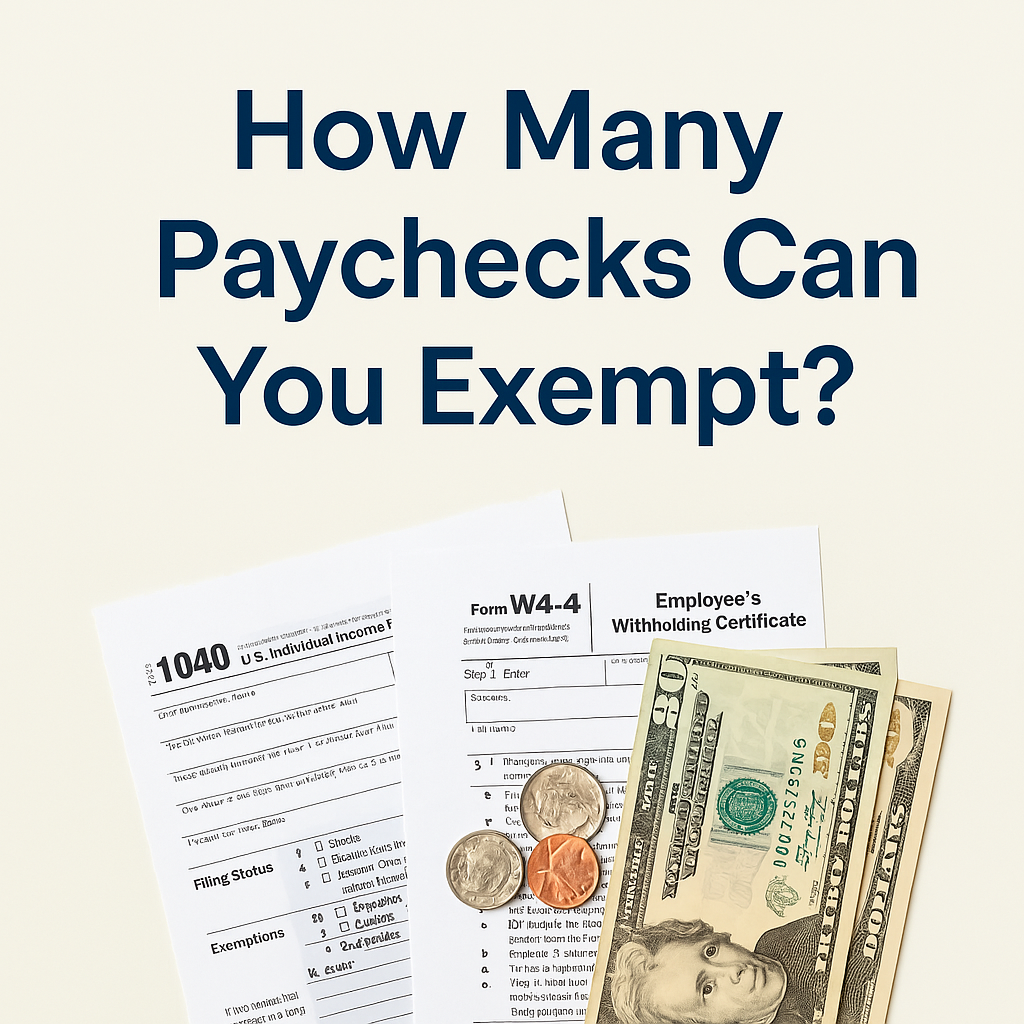When you start a new job or experience changes in your income, one of the most important financial decisions you make is how much tax should be withheld from your paycheck. The IRS allows employees to adjust their withholdings by claiming exemptions on their W-4 form. But how many paychecks can you exempt? And what are the implications of claiming exempt status?
This guide will break down paycheck exemptions, how they work, IRS rules, potential risks, and strategies to manage tax withholdings effectively.

Paycheck Exemptions
A paycheck exemption refers to an employee claiming an exemption from federal income tax withholding on their paycheck. When you claim exempt status on your W-4 form, your employer will not withhold federal income tax from your paycheck, meaning you will receive the full amount of your earnings before tax deductions.
How Do Exemptions Work?
Exemptions affect how much money is deducted from your paycheck for taxes. Employees who qualify for exemption status do not have federal income tax withheld. However, they may still be subject to Social Security, Medicare, and state taxes depending on where they live.
Example of Paycheck Exemptions in Action
If you earn $2,500 per paycheck and normally have $250 withheld for federal income taxes, claiming exempt status would mean you take home the full $2,500 without deductions for federal taxes. However, if you are not truly exempt, you may owe a large sum during tax season.
How Many Paychecks Can You Exempt?
The IRS allows eligible individuals to claim exempt status for all their paychecks in a given year. However, you must meet specific criteria to qualify for exemption status. The exemption applies only to federal income tax, not to other required deductions such as Social Security and Medicare.
IRS Criteria for Claiming Exemption
To claim exempt status, you must meet both of the following conditions:
- You did not owe any federal income tax in the previous year.
- You expect to owe no federal income tax in the current year.
If you meet these requirements, you can claim exemption and have no federal tax withheld from your paycheck.
State Tax Exemptions
Some states allow similar exemptions from state income tax withholding. However, rules vary by state, so check with your state’s tax agency to determine if you qualify.
IRS Rules and Limitations
If you claim exemption on your W-4 form, it is only valid for one calendar year. Employees must renew their exemption status by submitting a new W-4 form each year. If you fail to renew, your employer will withhold taxes based on your last filed W-4.
Penalties for Incorrectly Claiming Exempt Status
If you claim exempt when you are not eligible, the IRS may assess penalties and interest on unpaid taxes. If you knowingly provide false information on your W-4, you may face fines or even legal consequences.
How to Claim Exemptions on a W-4 Form
- Obtain a W-4 Form – You can get this from your employer or download it from the IRS website.
- Complete Personal Information – Fill out your name, address, and Social Security number.
- Check the Exempt Box – In Step 4(c), write “Exempt” if you qualify.
- Sign and Submit the Form – Ensure accuracy before giving it to your employer.
Common Mistakes to Avoid
- Claiming exempt without meeting IRS requirements.
- Forgetting to renew your exemption annually.
- Misunderstanding the impact of exemption on tax obligations.
Employer Responsibilities for Exempt Paychecks
Employers are required to:
- Accept a valid W-4 form unless they suspect fraud.
- Process the exemption and stop withholding federal taxes.
- Maintain accurate payroll records for tax reporting.
Frequency of W-4 Updates
Employers should remind employees to update their W-4 annually if they wish to continue claiming exemption.
Potential Risks and Consequences of Exempting Paychecks
If you claim exemption but do not qualify, you could face the following consequences:
- Facing a significant tax liability when filing your annual tax return.
- IRS penalties for incorrect withholding.
- Potential IRS audit if discrepancies are found in your tax return.
Can You Switch Back If You Made a Mistake?
Yes, you can submit a new W-4 form at any time to adjust your withholding and correct mistakes.
Alternative Ways to Reduce Withholding
Instead of claiming full exemption, you can:
- Increase the number of allowances to reduce withholding.
- Use the IRS Tax Withholding Estimator to calculate the optimal withholding amount.
Tax Credits and Deductions
- Earned Income Tax Credit (EITC) – Reduces tax liability.
- Child Tax Credit – Lowers taxable income.
- IRA or 401(k) Contributions – Lowers taxable wages.
FAQs About Paycheck Exemptions
Can I Claim Exempt for Only a Few Months?
Yes, but you must meet IRS eligibility criteria for the time period claimed.
Will I Still Owe Taxes If I Claim Exempt?
If you qualify for exemption, you will not owe taxes. However, if you do not qualify but still claim exemption, you may owe taxes when you file your return.
Can My Employer Refuse to Accept My Exemption Claim?
Employers cannot reject a valid W-4 form unless they believe it contains false information.
How Often Do I Need to Update My Exemption Status?
You must file a new W-4 each year if you wish to continue claiming exemption.
Conclusion
Claiming exempt status on your paycheck can provide temporary financial relief by increasing your take home pay. However, it should only be done if you genuinely qualify under IRS rules. If you’re unsure about your eligibility, consult a tax professional to avoid penalties and ensure you comply with tax laws. By understanding paycheck exemptions, you can make informed financial decisions that align with your tax situation.